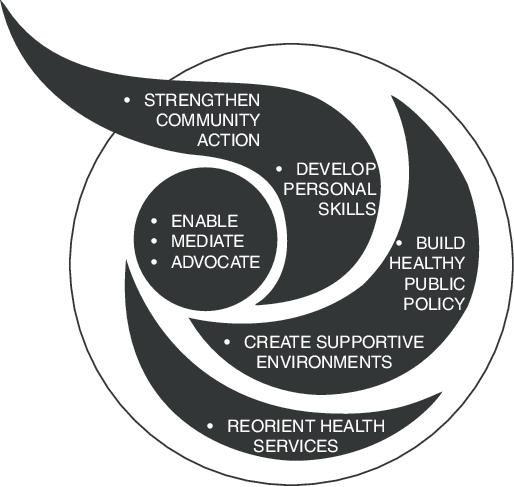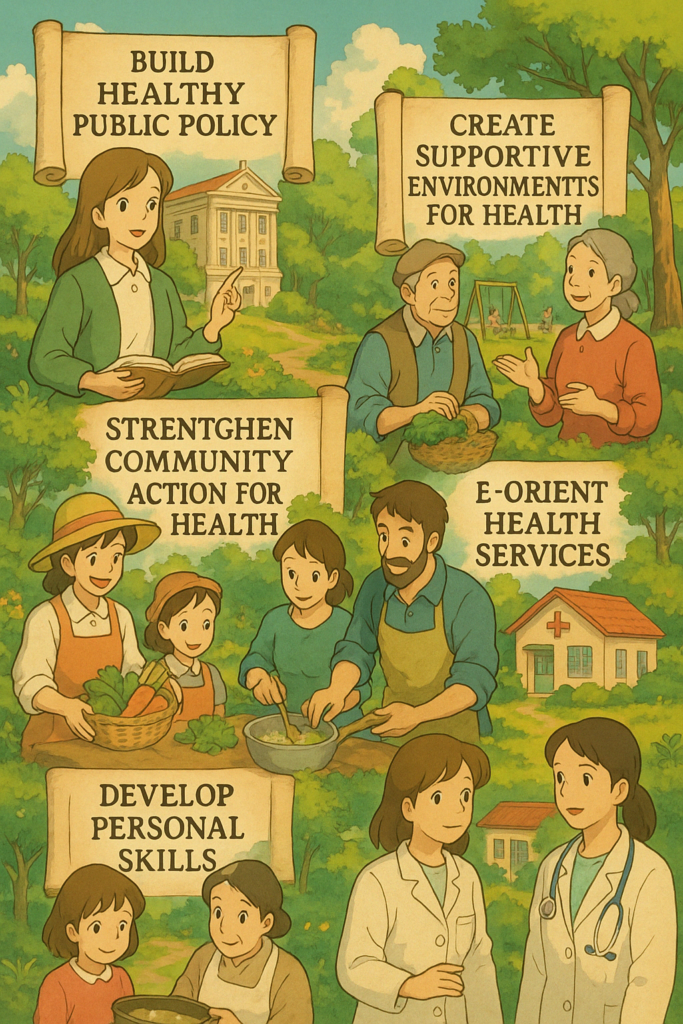Hey everyone! Ever stop to think about what it truly means to be healthy? It’s not just about dodging the sniffles or hitting the gym once in a while. It’s a much bigger picture, and today, we’re going to explore a fascinating journey in how we’ve come to understand and promote health – a journey marked by a pivotal moment called the Ottawa Charter
Before the Big Shift: The “Sick-Care” Era
Imagine a time when our main focus on health was primarily about what happened after someone got sick. The healthcare system was largely geared towards diagnosis and treatment – a vital role, no doubt! Public health efforts were mainly about tackling infectious diseases through things like sanitation and vaccinations. While crucial for their time, this “sick-care” model didn’t fully address why people were getting sick in the first place.

Think about it – have you ever felt like the solutions to old health problems don’t quite tackle the challenges we face today?
As the 20th century progressed, especially in more developed countries, a new set of challenges emerged: chronic diseases like heart disease, cancer, and diabetes became major health threats. It became clear that these weren’t just about germs; they were deeply connected to our lifestyles, the environments we lived in, and the social conditions we faced. The old “germ theory” explanation just wasn’t cutting it anymore.

People started questioning whether simply treating illness was enough. The limitations of the medical model became apparent. Simultaneously, there was a growing awareness of social inequalities – how factors like poverty, lack of education, and discrimination significantly impacted people’s health.
What are some of the biggest health challenges you see in your own community?
A crucial turning point arrived in 1978 with the Alma-Ata Declaration. This global declaration, spearheaded by the World Health Organization (WHO) and UNICEF, boldly stated “Health for All by the Year 2000.” It emphasized primary healthcare, the importance of community participation, and the need to address the social determinants of health. Alma-Ata planted the seed for a broader way of thinking about health.
The Ottawa Charter: A New Blueprint for Health (1986)
Building on the momentum of Alma-Ata and the growing understanding of health’s complexities, a landmark event took place in Ottawa, Canada, in 1986. The First International Conference on Health Promotion gave birth to the Ottawa Charter for Health Promotion. This wasn’t just another health document; it was a revolutionary blueprint for creating a healthier world.
The Ottawa Charter shifted the focus from simply treating illness to actively promoting well-being. It recognized that health is influenced by a wide range of factors – individual choices, social support, economic conditions, and the environment.
It laid out five key action areas, like essential steps in a recipe for a healthier community:

- Build Healthy Public Policy: Think of this as gathering your ingredients for a healthy community. These are the foundational rules and regulations set by governments and organizations that make healthy choices the easier, default options for everyone. Examples include laws against smoking in public places, taxes on unhealthy foods, or regulations ensuring clean water and air.
- Create Supportive Environments for Health: Once you have the ingredients, you need the right kitchen – a supportive environment for health. This is about designing and nurturing spaces, both physical (like parks and accessible buildings) and social (like strong community networks), where well-being is encouraged and thriving. It’s about making sure the tools and atmosphere naturally lead to healthier actions.
- Strengthen Community Action for Health: Now it’s time for the community chefs to get involved – strengthening community action for health. This is where people within a community come together, sharing their unique knowledge and taking ownership of their local health initiatives. It’s like everyone contributing their special flavors to the dish, creating solutions that are tailored to their specific needs and context.
- Develop Personal Skills: Even with the best ingredients and kitchen, individuals need to know how to cook – that’s developing personal skills. This involves providing the education, resources, and opportunities for people to learn and adopt healthy behaviors, empowering them to make informed choices and take control of their own well-being. Think of health education programs, cooking classes, or stress management workshops.
- Re-orient Health Services: Finally, you need to ensure the restaurant itself – the health services – is focused on serving the right kind of food. This means re-orienting health services to not just treat illness when it occurs, but to actively promote health and prevent problems in the first place. It’s about making well-being the main course, with healthcare professionals also focusing on education, prevention, and addressing the root causes of ill health.

See how these five areas connect? Strong policies lay the groundwork for supportive environments, which in turn empower community action, equipping individuals with essential skills, all supported by a health system that prioritizes keeping people well. It’s a beautiful and interconnected cycle!
Ready to test your understanding? Keep an eye out for a quick multiple-choice quiz coming right up!
PNEUMONIC TO REMEMBER
Remembering the Key Actions: The “Policy, Place, People, Skills, Services” Approach
To easily recall the five key action areas of the Ottawa Charter, think of this simple phrase:
Please Put Pickles Sideways Soon.
- Policy (Build Healthy Public Policy)
- Place (Create Supportive Environments for Health)
- People/Participation (Strengthen Community Action for Health)
- Skills (Develop Personal Skills)
- Services (Re-orient Health Services)
ONE MORE
Boys Can Sometimes Dance Really well.
- Build Healthy Public Policy
- Create Supportive Environments for Health
- Strengthen Community Action for Health
- Develop Personal Skills
- Re-orient Health Services
So, the next time you think about health, remember the journey from a focus on just treating sickness to the broader vision of building wellness for all, guided by the principles of the Ottawa Charter. It’s a continuous evolution, and understanding its roots helps us shape a healthier future!
The Ottawa Charter for Health Promotion primarily shifted the focus of public health towards:
a) Treating infectious diseases.
b) Addressing acute medical emergencies.
c) Promoting overall well-being and preventing illness.
d) Focusing solely on individual lifestyle choices.
Which of the following best exemplifies “Building Healthy Public Policy” according to the Ottawa Charter?
a) A community group organizing a weekly exercise program.
b) A school implementing a healthier cafeteria menu.
c) A government increasing taxes on tobacco products.
d) A doctor advising a patient on managing their diabetes
Creating accessible parks and green spaces within cities is an example of which action area of the Ottawa Charter?
a) Developing Personal Skills.
b) Strengthening Community Action for Health.
c) Creating Supportive Environments for Health.
d) Re-orienting Health Services
A local initiative where residents come together to establish a community garden and share healthy produce directly addresses which Ottawa Charter action area?
a) Build Healthy Public Policy.
b) Create Supportive Environments for Health.
c) Strengthen Community Action for Health.
d) Develop Personal Skills
Providing free workshops on nutrition and cooking skills to community members directly aligns with
a) Re-orienting Health Services.
b) Developing Personal Skills.
c) Building Healthy Public Policy.
d) Strengthening Community Action for Health.
Imagine a healthcare clinic that not only treats illnesses but also offers regular workshops on stress management and healthy eating. This shift in focus represents:
a) Building Healthy Public Policy.
b) Creating Supportive Environments for Health within the clinic.
c) Re-orienting Health Services.
d) Strengthening Community Action for Health within the healthcare setting.
A town council is considering two options to improve the health of its citizens: building a new hospital or investing in creating more bike paths and pedestrian-friendly zones. According to the principles of the Ottawa Charter, which approach aligns more broadly with health promotion?
a) Building a new hospital, as it directly addresses illness.
b) Investing in bike paths and pedestrian zones, as it creates supportive environments.
c) Both options are equally aligned with the Ottawa Charter.
d) Neither option directly aligns with the Ottawa Charter.
A non-profit organization aims to reduce smoking rates in a specific community. Which of the following strategies would best reflect a comprehensive Ottawa Charter approach?
a) Providing individual counseling sessions for smokers.
b) Lobbying for increased cigarette taxes and smoke-free public spaces, while also supporting community-led cessation programs.
c) Distributing pamphlets about the dangers of smoking at local clinics.
d) Focusing solely on running advertisements discouraging smoking.
Consider a scenario where a significant portion of students in a school district lacks access to nutritious breakfast options at home. Applying the Ottawa Charter framework, which of the following interventions would be the MOST comprehensive and sustainable approach to address this issue?
a) Providing individual counseling to students about the importance of breakfast.
b) Establishing a school-based breakfast program while also advocating for policies that improve food security within the local community.
c) Partnering with local grocery stores to offer discounts on breakfast items for students.
d) Educating parents through workshops on preparing quick and healthy breakfasts.
A newly developed technology allows individuals to track their physical activity and provides personalized feedback. While this tool can help with “Developing Personal Skills,” what broader Ottawa Charter action area would be most crucial to consider to ensure this technology benefits the entire community and reduces health inequities?
a) Re-orienting Health Services to integrate the technology into patient care.
b) Strengthening Community Action for Health by creating online support groups for users.
c) Building Healthy Public Policy to ensure equitable access to the technology and digital literacy training for all socioeconomic groups.
d) Creating Supportive Environments for Health by designing public spaces that encourage the use of the technology (e.g., charging stations)
“Fantastic job working through these questions! The Ottawa Charter provides a roadmap, and you’re now better equipped to navigate it. Go out there and be a champion for health in your own way!”
Answers
c) Promoting overall well-being and preventing illness.
- Explanation: The Ottawa Charter marked a significant shift from a disease-focused approach to one that emphasizes holistic well-being and proactive measures to prevent illness before it occurs.
c) A government increasing taxes on tobacco products.
- Explanation: Building Healthy Public Policy involves actions at the governmental level that make healthier choices easier for the entire population through regulations, laws, and fiscal measures.
c) Creating Supportive Environments for Health.
- Explanation: Supportive environments are about making the physical and social surroundings conducive to health. Accessible parks encourage physical activity and provide spaces for social interaction.
c) Strengthening Community Action for Health.
- Explanation: This action area focuses on empowering communities to identify their health needs and take collective action to address them. A community garden is a prime example of residents working together for a healthier outcome.
b) Developing Personal Skills.
- Explanation: Providing education and resources to individuals so they can make informed decisions and develop skills related to healthy behaviors is the core of developing personal skills.
c) Re-orienting Health Services.
- Explanation: This involves shifting the focus of healthcare from primarily treating illness to also actively promoting health and preventing disease. Offering workshops on lifestyle factors is a key aspect of this re-orientation.
b) Investing in bike paths and pedestrian zones, as it creates supportive environments.
- Explanation: While a hospital addresses illness (sick-care), investing in infrastructure that encourages physical activity and cleaner air aligns more directly with the Ottawa Charter’s broader health promotion approach by creating supportive environments for the entire population.
b) Lobbying for increased cigarette taxes and smoke-free public spaces, while also supporting community-led cessation programs.
- Explanation: This option combines building healthy public policy (taxes and smoke-free spaces) with strengthening community action (cessation programs), reflecting a multi-pronged Ottawa Charter approach.
b) Establishing a school-based breakfast program while also advocating for policies that improve food security within the local community.
- Explanation: This option addresses the immediate need (breakfast program – creating a supportive environment within the school) while also tackling the root cause (food insecurity – building healthy public policy) for a more sustainable impact.
c) Building Healthy Public Policy to ensure equitable access to the technology and digital literacy training for all socioeconomic groups.
- Explanation: While the technology directly aids “Developing Personal Skills,” ensuring equitable access and the ability to use it effectively across all socioeconomic groups requires policy interventions to bridge the digital divide and prevent the technology from widening health inequities.